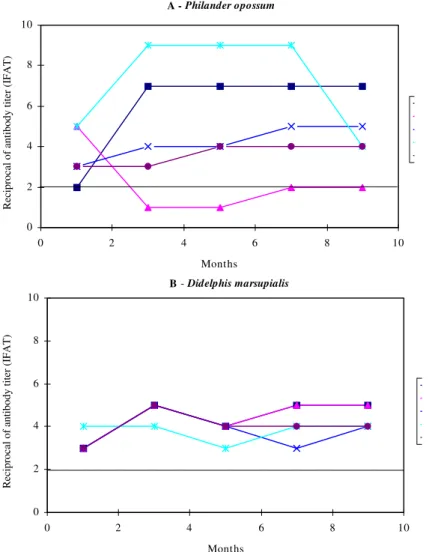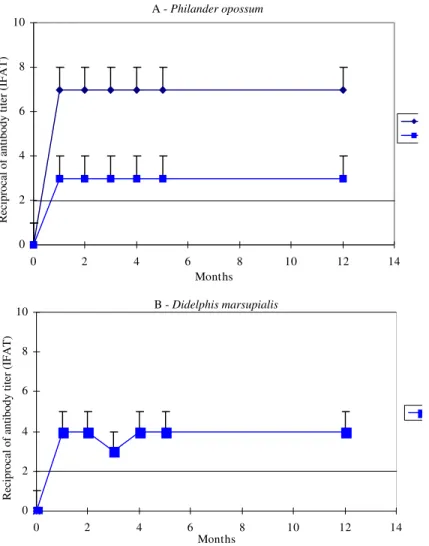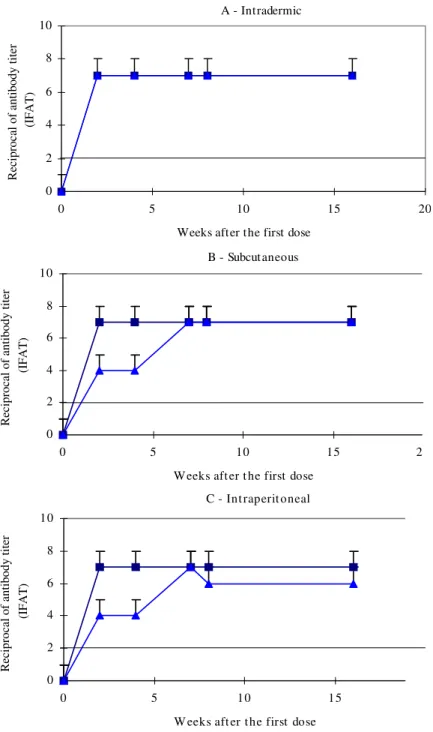371 371371 371371 Mem Inst Oswaldo Cruz, Rio de Janeiro, Vol. 94(3): 371-376, May/Jun. 1999
Humoral Immune Response Kinetics in
Philander opossum
and
Didelphis marsupialis
Infected and Immunized by
Trypanosoma cruzi
Employing an Immunofluorescence
Antibody Test
Ana Paula Legey, Ana Paula S Pinho, Samanta C Chagas Xavier,
Leonor L Leon
*, Ana Maria Jansen/
+Departamento de Protozoologia *Departamento de Imunologia, Instituto Oswaldo Cruz, Av. Brasil 4365, 21045-900 Rio de Janeiro, RJ, Brasil
Philander opossum and Didelphis marsupialis considered the most ancient mammals and an evolu-tionary success, maintain parasitism by Trypanosoma cruzi without developing any apparent disease or important tissue lesion. In order to elucidate this well-balanced interaction, we decided to compare the humoral immune response kinetics of the two didelphids naturally and experimentally infected with T. cruzi and immunized by different schedules of parasite antigens, employing an indirect fluorescence antibody test (IFAT). Both didelphids responded with high serological titers to different immunization routes, while the earliest response occurred with the intradermic route. Serological titers of naturally infected P. opossum showed a significant individual variation, while those of D. marsupialis remained stable during the entire follow-up period. The serological titers of the experimentally infected animals varied according to the inoculated strain. Our data suggest that (1) IFAT was sensitive for follow-up of
P. opossum in natural and experimental T. cruzi infections; (2) both P. opossum and D. marsupialis are able to mount an efficient humoral immune response as compared to placental mammals; (3) experi-mentally infected P. opossum and D. marsupialis present distinct patterns of infection, depending on the subpopulation of T. cruzi, (4) the differences observed in the humoral immune responses between P. opossum and D. marsupialis, probably, reflect distinct strategies selected by these animals during their coevolution with T. cruzi.
Key words: Trypanosoma cruzi - Philander opossum - Didelphis marsupialis -immunoglobulins
Didelphid marsupials, which originated in the late Cretaceous and are considered the most an-cient terrestrial mammals, are extremely adaptable to different environments and are considered an evolutionary success. Paradoxically, the marsupi-als’ immune system was thought to be less com-plex than that of other mammals (Wirtz & Westfall 1967, Rowlands & Dudley 1968, Rowlands 1970, Marx Jr et al. 1971). However, the marsupial Di-delphis marsupialis, an important wild reservoir of Trypanosoma cruzi, maintains an harmonic in-teraction with this parasite (Deane et al. 1984) with no important tissue lesions (Carreira et al. 1996); depending on the inoculated strain, it may present a high level of immunoglobulins (Jansen et al. 1985, 1991).
Previous reports had already shown that the indirect fluorescent antibody test (IFAT) is a sen-sitive test for the diagnosis and follow-up of ex-perimental and natural T. cruzi infections in D. marsupialis (Jansen et al. 1985), contrary to Miles (1979), Minter-Goedbloed et al. (1980), and Luckins and Miles (1982). Specific antibodies were directly correlated with the control of circulating blood parasites in the D. marsupialis experimen-tally infected with F or sylvatic strains. However, the early control of infections in opossums inocu-lated with Y strain probably occurs by nonspecific mechanisms (Jansen et al. 1991).
Another important reservoir of T. cruzi, Phi-lander opossum, lives in the same sylvatic habitat as D. marsupialis and also efficiently controls para-sitism by T. cruzi, although histopathological stud-ies in this marsupial have shown more lym-phomacrophagic infiltrates than D. marsupialis
(Pinho et al. 1996). D. marsupialis differs from P. opossum in experimental infections (Jansen et al. 1991, Pinho et al. 1995), but data on the humoral immune response of this species have not been
+Corresponding author. Fax: +55-21-280.1589
E-mail: jansen@gene.dbbm.fiocruz.br Received 7 August 1998
372 372 372 372
372 P. opossum and D. marsupialis Infected by T. cruzi Ana Paula Legey et al.
shown in detail. The search for insight into the humoral mechanisms involved in natural and ex-perimental infections in these two didelphids in-fected by T. cruzi, led us (1) to adapt an IFAT for the diagnosis of T. cruzi infections in P. opossum
and (2) to follow the kinetics of humoral immune responses in both didelphids.
MATERIALS AND METHODS
Didelphids - Naturally infected P. opossum
(n=5) and D. marsupialis (n=5) were captured in the Caleme area near Teresópolis (State of Rio de Janeiro, Brazil). For experimental infection and immunization, newly weaned animals (n= 18) ob-tained from females born and reared in our labora-tory were used. All animals were caged individu-ally and fed on dog food, fruit, and eggs.
Parasites - The T. cruzi strains used in the ex-periments were as follows: Y (isolated from a hu-man patient by Silva & Nussenzweig 1953); C13 (isolated from naturally infected P. opossum), F (originally isolated as T. lewisi and afterwards iden-tified as T. cruzi by Deane & Kloetzel 1974). All strains were maintained by (a) cyclical passages through triatomines, opossums, and LIT medium and (b) successive LIT medium passages.
Inoculation schedules - Experimental infections (Table): all animals were infected subcutaneously in the inner part of the right thigh. Two litters (three specimens/litter) of P. opossum were inoculated with either Y or C13 metacyclic trypomastigotes (500 parasites/g of body weight), and one litter (three specimens) of D. marsupialis were inocu-lated with strain C13 (1000 parasites/g of body weight). Immunization (Table): one litter (three specimens/litter) of P. opossum and D. marsupialis
were immunized with strain F total antigen as fol-lows: 1st dose - 1.5 mg protein (ptn) and
Com-plete Freunds’ Adjuvant; 2nd dose - 1.5 mg ptn and Incomplete Freunds’ Adjuvant; 3rd dose - 5 mg ptn and Incomplete Freunds’ Adjuvant.
Parasitological follow-up - Briefly, fresh blood smears of infected P. opossum and D. marsupialis
were examined after inoculation every two days, and patent parasitemia was followed by counting parasites in a Neubauer chamber. Animals with negative blood smears were submitted to hemocultures in NNN medium with a LIT over-lay. Hemocultures were examined every two weeks over a period of two months. Weekly examination for parasites of the scent glands was performed by gentle manual squeezing of the glands.
IFAT - An indirect fluorescent antibody test, as described elsewhere (Jansen et al. 1985), has been adapted to follow-up P. opossum infected by T. cruzi. The antigen, consisting of epimastigote forms of T. cruzi F strain, was adjusted to 40 parasites by microscopic field examination (40x) and stored at -20oC. P. opossum and D. marsupialis sera from the natural and experimental infections were ob-tained from blood samples taken from the tail vein. Positive control serum was obtained from P. opos-sum/D. marsupialis immunized with parasite anti-gens, and negative control serum was obtained from uninfected animals, born and kept in captiv-ity. Rabbit antisera to P. opossum/D. marsupialis
immunoglobulins (Ig) and a fluorescein conjugated anti-rabbit Ig (Sigma) were used.
RESULTS
Fig. 1 demonstrates the follow-up of the humoral immune response kinetics of P. opossum and D. marsupialis naturally infected with T. cruzi. Fig. 1a shows an important serological variation in the natu-rally infected P. opossum, where the total anti-T. cruzi
Ig levels varied from 1:80 to 1:5120. On the other
TABLE Inoculation shedules
Experiment Specie Source of No. of Inoculation
inoculation inoculation route
C13 01 (500MT/b.w.) SC
Philander opossum
Experimental Y 01 (500 MT/b.w.) SC
infection
Didelphis marsupialis C13 01 (1000MT/b.w.) SC
F 03 (soluble fraction) ID
Philander opossum F 03 (soluble fraction) SC
F 03 (soluble fraction) IP
Immunization
F 03 (soluble fraction) ID
Didelphis marsupialis F 03 (soluble fraction) SC
F 03 (soluble fraction) IP
373 373373 373373 Mem Inst Oswaldo Cruz, Rio de Janeiro, Vol. 94(3), May/Jun. 1999
hand, naturally infected D. marsupialis displayed serological titers from 1:80 to 1:160 (Fig. 1b).
Serological follow-up of experimentally in-fected opossums showed that P. opossum and D. marsupialis presented similar antibody titers (1:80-1:160) when inoculated with the C13 strain. However, P. opossum inoculated with the Y strain presented the highest serological titers (1:1280) (Fig. 2).
Sera from immunized didelphids showed high levels of total Ig, regardless of the immunization route. On the other hand D. marsupialis reached the serological peak in the 2nd week after the first antigen dose, earlier than P. opossum (Fig. 3).
The natural infections were subpatent and stable: 41% (P. opossum) and 30% (D. marsupialis) of hemocultures performed, during the follow-up, were positive.
The experimental infections in both didelphids resulted in a low patent parasitemia with scarce positive fresh blood smears, and no parasites were observed in the lumen of the scent glands. During follow-up, 33% and 94% (C13 and Y strain, re-spectively) of the hemocultures of P. opossum and 12% of those from D. marsupialis (C13 strain) were positive.
DISCUSSION
As described for D. marsupialis (Jansen et al. 1985), IFAT is also sensitive in the diagnosisof T. cruzi infection in this other reservoir of T. cruzi: P. opossum. Infection detected by the serological test (IFAT) could be confirmed, in all cases, by posi-tive hemocultures. The characterization of the iso-lates were revealed by eletrophoretic profile of isoenzymes (Pinho et al. 1997) and the
non-tran-Fig. 1: levels of total anti Trypanosoma cruzi antibodies in five Philander opossum (A) and Didelphis marsupialis (B) naturally
infected with T. cruzi. Immunoglobulin levels were detected by an indirect immunofluorescence antibody test, and curves were
plotted as log 2 of the dilution titers. The line parallel to the X axis (2) indicates the lowest diagnostic titer. A - Philander opossum
0 2 4 6 8 10
0 2 4 6 8 10
Months
Reciprocal of antibody titer (IFAT)
B - Didelphis marsupialis
0 2 4 6 8 10
0 2 4 6 8 10
Months
374 374 374 374
374 P. opossum and D. marsupialis Infected by T. cruzi Ana Paula Legey et al.
0 2 4 6 8 10
0 2 4 6 8 10 12 14
Months
Reciprocal of antibody titer (IFAT)
Fig. 2: levels of totalanti-Trypanosoma cruzi antibodies in five Philander opossum from a litter infected with the Y and C13
strains (A) and Didelphis marsupialis infected with the C13 strain (B). Each point represents mean values for the litter. All other
data as in the caption to Fig. 1.
scribed spacer of the mini-exon gene (Fernandes et al. 1998). Moreover, uninfected laboratory born and reared P. opossum presented negative IFAT.
The serological variation in naturally infected
P. opossum (Fig. 1) suggests the following: (1) re-activation of a chronic infection or a recent infec-tion in the two animals with rising serological ti-ters; (2) control of the infection in an opossum re-sulting in a decrease in the serological titer; and (3) stable infection reflected by constant titers dur-ing the follow-up of two P. opossum. Alternatively, the serological variation could be the consequence of the interaction of P. opossum with different T. cruzi subpopulations, since P. opossum is not a strict “biological filter”, in contrast to D. marsupialis (Pinho et al. 1995). This hypothesis can be confirmed by our data from naturally in-fected D. marsupialis that presented constant lev-els of immunoglobulins during the whole
infec-tion. Similar results were obtained by Jansen et al. (1985). Differences in the pattern of infection in naturally infected opossums could also be observed in ally infected opossums in recent report.
Differences in immune response in experimen-tal infections (Fig. 2) suggest peculiarities in the interaction between T. cruzi and these two didelphid species rather than any distinguishing trait of the didelphids’ immune response, since immunized P. opossum and D. marsupialis (Fig. 3) showed the same humoral immune response. We did not note any differences in the antibody production in the patent and subpatent phases. This homogeneous humoral response displayed by the experimentally infected P. opossum and D. marsupialis reinforce this hypothesis.
The experimental infection with strain C13 re-sulted in a similar serological pattern in P. opossum
and D. marsupialis, despite the two-fold higher in-p
0 2 4 6 8 10
0 2 4 6 8 10 12 14
Months
Reciprocal of antibody titer (IFAT)
A - Philander opossum
375 375375 375375 Mem Inst Oswaldo Cruz, Rio de Janeiro, Vol. 94(3), May/Jun. 1999
Fig. 3: levels of total anti-Trypanosoma cruzi antibodies in Philander opossum and Didelphis marsupialis immunized by the
intradermic (A), subcutaneous (B), and intraperitoneal (C) routes with total antigen of T. cruzi. All other data as in the caption to
Fig. 1.
oculum in the latter. However P. opossum infected with Y strain, displayed significantly higher sero-logical titers than previously described for D. marsupialis (Jansen et al. 1985, 1991). These find-ings point to the peculiarities in the T. cruzi-P. opos-sum and T. cruzi-D. marsupialis interactions and also suggest that D. marsupialis seems to control the T. cruzi infection more efficiently than P. opossum.
The correlation in serological and parasitologi-cal results could be confirmed by the follow-up of the experimental infection. The animals dis-played a significantly lower antibody titers and positive hemocultures suggesting a lower parasitic burden in these host.
All these findings confirm that the marsupial immune response is comparable to that of A - Intradermic
0 2 4 6 8 10
0 5 10 15 20
Weeks after the first dose
Reciprocal of antibody titer
(IFAT)
B - Subcut aneous
0 2 4 6 8 10
0 5 10 15 2
W eeks aft er t he first dose
Reciprocal of antibody titer
(IFAT)
C - Int raperit oneal
0 2 4 6 8 10
0 5 10 15
W eeks aft er t he first dose
Reciprocal of antibody titer
376 376 376 376
376 P. opossum and D. marsupialis Infected by T. cruzi Ana Paula Legey et al.
placentals and that the IFAT is considered sensi-tive for following natural and experimental infec-tions in didelphids, contrary to the prevailing opin-ion several years ago (Miles 1979, Minter-Goedbloed et al. 1980, Luckins & Miles 1982).
Our data indicate that maternal antibodies trans-ferred during lactation could probably confer pro-tection to young P. opossum in the pouch, since newly weaned animals control this parasitism in experimental infections as do naturally infected young animals. It has been reported that marsupi-als acquire antibodies only a few hours after suck-ling for the first time (Hindes & Mizell 1976), and that D. marsupialis maternal antibodies confer par-tial protection to the young (Jansen et al. 1994).
Although highly speculative, it is tempting to hypothesize that P. opossum and D. marsupialis, two closely related species, selected distinct strat-egies to efficiently control the parasitism by T. cruzi, during their coevolution. Our result also sug-gest that this well-balanced interaction of T. cruzi
with didelphids is more complex than previously belived.
REFERENCES
Carreira JC, Jansen AM, Lenzi H, Deane MP 1996. His-topathological study of Didelphis marsupialis natu-ral and experimental infections by Trypanosoma cruzi. Mem Inst Oswaldo Cruz 91: 609-618. Deane MP, and Kloetzel J 1974. Lack of protection
against Trypanosoma cruzi by multiple doses of Try-panosoma lewisi forms. A discussion os some strains of “lewisi”. Exp Parasitol 35: 406-410.
Deane MP, Lenzi HL, Jansen A 1984. Trypanosoma cruzi: vertebrate and invertebrate cycles in the same mammal host, the opossum Didelphis marsupialis. Mem Inst Oswaldo Cruz 79: 513-515.
Fernandes O, Mangia RH, Lisboa CV, Pinho AP, Morel CM, Zingales B, Campbell DA, Jansen AM 1998. The complexity of sylvatic cycle of Trypanosoma cruzi in Rio de Janeiro state (Brazil) revealed by the non-transcribed spacer of the mini-exon gene. Para-sitology 118: 1-6.
Hindes RD, Mizell M 1976. The origin of immunoglo-bulins in opossum embryos. Develop Biol 53: 49-61.
Jansen AM, Deane, MP, 1994. Trypanosoma cruzi in the opossum Didelphis marsupialis: absence of neo-natal transmission and partial protection by mater-nal antibodies in experimental infections. Mem Inst Oswaldo Cruz 89: 41-45.
Jansen AM, Leon L, Machado GM, Da Silva MH
Souza-Leão SM, Deane MP 1991. Trypanosoma cruzi in the opossum Didelphis marsupialis: Parasitological and serological follow-up of the acute infection. Exp Parasitol 73: 249-259.
Jansen AM, Moriearty, PL Galvão-Castro B, Deane MP 1985. Trypanosoma cruzi in the opossuns Didelphis marsupialis: an indirect fluorescent antibody test for the diagnosis and follow up of natural and experi-mental infections. Trans R Soc Trop Med Hyg 79: 474-477.
Luckins AG, Miles MA 1982. Detection of antibodies to Trypanosoma cruzi in the South American opos-sum (Didelphis marsupialis) Trans R Soc Trop Med Hyg 76: 9-32.
Marx Jr JJ, Burrell R, Fisher SQ 1971. A study of the afferent and efferent limbs of the immune response in opossums. J Immunol 106: 1043-1049.
Miles MA 1979. Transmission cycles and the heteroge-neity of Trypanosoma cruzi, p. 117-196. In WH Lumsden, DA Evans (eds), Biology of the Kinetoplastida, Academic Press, London, New York and San Francisco.
Minter-Goedbloed E, França S, Draper CC 1980. The latex agglutination for Trypanosoma cruzi: Unsuit-able for testing animals. Am J Trop Med Hyg 83: 157-160.
Pinho AP, Cabrera BA, Gomes-Cardoso L, Cupollilo E, Jansen AM 1997. The transmission cycle and the heteregeneity of trypanosoma cruzi isolates derived from marsupials (Didelphis marsupialis and Philan-der opossum) captured in Teresopolis, Rio de Janeiro. Mem Inst Oswaldo Cruz 92 (Suppl.): 121. Pinho AP, Legey AP, Trajano V, Marchewsky RS, Jansen
AM 1995. Trypanosoma cruzi in marsupials (Didel-phis marsupialis and Philander opossum) and bugs: biological and biochemical characterization of the isolates. Mem Inst Oswaldo Cruz 90 (Suppl.): 92. Pinho AP, Mangia RH, Nehme N, Morel CM, Cupolillo
E, Jansen AM 1996. The complexity of the circula-tion of Trypanosoma cruzi in the natural environ-ment: biological and biochemical characterization of marsupial and Rhodnius prolixus isolates. Mem Inst Oswaldo Cruz 91 (Suppl.): 220.
Rowlands Jr DT, Dudley MA 1968. The isolation of im-munoglobulins of the adult opossum (Didelphis virginiana). J Immunol 100: 736-743.
Rowlands Jr DT 1970. The immune response of dult opossums (Didelphis virginiana) to the bacterioph-age f2. Immunology 18: 149-155.
Silva LHP, Nussenzweig V 1953. Sobre uma cepa de Trypanosoma cruzi altamente virulenta para o camundongo branco. Fol Clin Bio 20: 191-208. Wirtz GH, Westfall SA 1967. Imunne complement of



